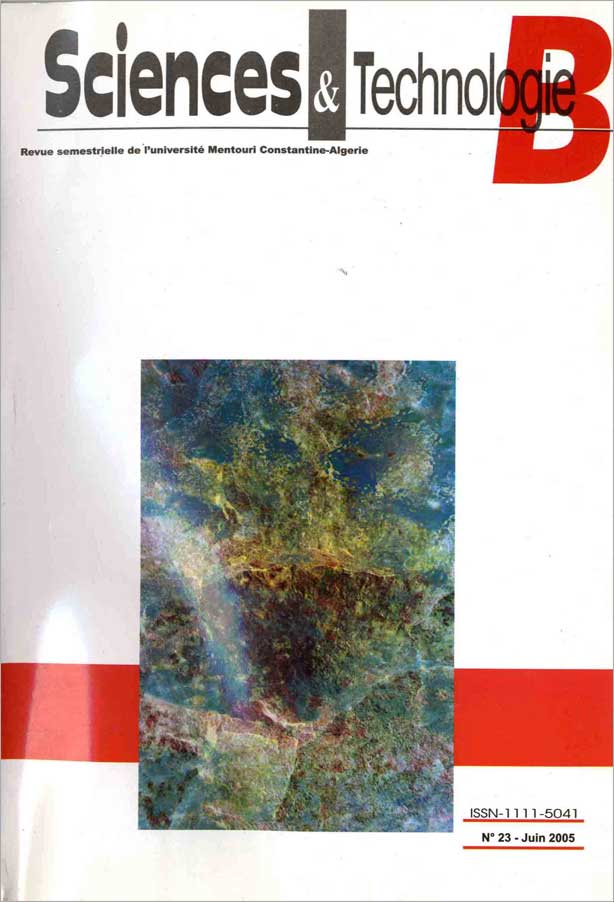SUPERVISION NEURO-FLOUE A APPRENTISSAGE GENETIQUE D’UN PID ROBUSTE
Mots-clés :
PID flou, algorithme génétique, réseau de neurones, Fuzzy PID, genetic algorithms, neural networksRésumé
This article presents the application of a new generation of fuzzy logic supervisor (FLS) to the highly nonlinear systems. The dominant parameters characterizing the base of fuzzy knowledge: scaling factors of the Input/Output (I/O) variables,membership functions and the rule consequences are optimized by using the Genetic Algorithms (GA). The conventional PID in its improved form, where the coefficients of different actions KP, KI and KD are nonlinear variables. A fuzzy inference
system with multilayer neural network structure with genetic training plays the role of supervisor who allows giving optimal functions to these coefficients.
The fuzzy structure is specified by a combination of the mixed Takagi-Sugeno’s and Mamdani’s fuzzy Reasoning TSM-FR.The mixed integer-binary optimal coding is utilized to construct the chromosomes, which define the same of necessary prevailing parameters for the conception of the desired supervisor. This new fuzzy supervisor stands out by a non standard gain (output scaling factor) which varies linearly with the fuzzy inputs. It becomes similar to the conventional PID controller with non-linearly variable coefficients. Computer simulation indicates that the designed fuzzy supervisor is satisfactory in PID control of a nonlinear system ‘Inverted Pendulum’.
Références
Yongho Lee and Sunwon Park, "PID controllers tunning for
desired closed-loop responses for SI/SO systems", Aiche
journal, Vol. 44, No. 4, January 1998, 106-115.
Aström, K.J. and T. Hägglund, “PID Controllers: Theory,
Design, and Tuning”,Instrument Society of America, 1995.
Marlin, T. E, “Process Control. Designing Processes and
Control Systems for Dynamic Performance”,Mc Graw-Hill,
L. A. Zadeh, "Fuzzy sets", Information and Control, Vol. 8,
, pp. 338-353.
Jhy-Shing Roger Jang and Chuen-Tsai Sun, "Neuro fuzzy
modeling and control", Proceedings of the IEEE, Vol. 83, No.
, March 1995, pp. 378-406.
David E. Goldberg, ‘‘Algorithmes génétiques: exploration,
optimisation et apprentissage automatique’’, AddisonWesley, 1994.
J. Holland, ‘‘Adaptation in natural and artificial systems’’,
University of Michigan Press, 1975.
Yigang Shi and P.C. Sen, "ANew Defuzzification Method
for Fuzzy Control of Power Converters”, IEEE porceeding
on Fuzzy Systems, 2000.
Mamdani, E. H., “Application offuzzy algorithms for simple
dynamic plant”, Proc. IEE, D-121, 1974, pp. 1558-1588.
Mamdani, E. H., and Assilian, “An experiment in linguistic
synthesis with a fuzzy logic controller”, International Journal
of Man- Machine Studies, Vol. 7, 1975, pp. 1-13.
M. Sugeno and G. T. Kang, "Structure identification of fuzzy model", Fuzzy sets and systems, Vol. 28, 1988, pp.15-33.
Jhy-Shing Roger Jang and Chuen-Tsai Sun, "Neuro fuzzy
modeling and control", Proceedings of the IEEE, Vol. 83, No.
, March 1995, pp. 378-406.
X. W. Yan, Z. D. Deng and Z.Q. Sun, “Genetic TakagiSugeno-fuzzy reinforcement learning”, Proceeding of the 2001 IEEE, International Symposium On Intelligent Control,
September 5-7, 2001, Mexico city, Mexico, pp. 67-72.
Chia-Feng Juang and Yuan-Chang Liou, “A TSK-type
recurrent fuzzy network for dynamic systems processing via
supervised and reinforcement learning”, 2001 IEEE International Fuzzy Systems Conference, pp. 240-243.
Hao Ying, "Constructing nonlinear variable gain controllers
via the Takagi-Sugeno fuzzy control", IEEE transactions on
fuzzy systems, Vol. 6, No. 2, May 1998, pp. 226-234.
A. Homaifar and Ed Mc Cormick, "Simultaneous design of
membership functions and rules sets for fuzzy controllers
using genetic algorithms", IEEE Transactions On Fuzzy Systems, Vol. 3, No. 2, May 1995, pp. 161-176.
Jinwoo Kim, Yoonkeon Moon, and Bernard P. Zeigler,
"Designing fuzzy net controllers using genetic algorithms",
IEEE control systems, June 1995, pp. 66-72.
Jinwoo Kim, and Bernard P. Zeigler, "Designing fuzzy logic
controllers using a multiresolutional search paradigm", IEEE
Transaction On Fuzzy Systems, Vol. 4, No. 3, August 1996,
pp. 213-226.
Sanjay Kumar Sharma and George W. Irwin, “Fuzzy Coding
of Genetic Algorithms”, IEEE Transactions on Evolutionary
Computation, Vol. 7, No. 4, August 2003, pp 344-355.
Teo Lian Seng et al., “Tuning of a neuro-fuzzy controller by genetic algorithm”, IEEE Transactions OnSystems,Man, and
Sybernetics-Part B: Cybernetics, Vol. 29, No. 2, April 1999,
pp. 226-236.
Téléchargements
Publié-e
Comment citer
Numéro
Rubrique
Licence
Les auteurs publiant dans cette revue acceptent les termes suivants :- Les auteurs détiennent le droit d'auteurs et accordent à la revue
le droit de première publication, avec l’ouvrage disponible simultanément [SPÉCIFIER LA PÉRIODE DE TEMPS] après publication, sous la licence Licence d’attribution Creative Commons qui permet à d'autres de partager l'ouvrage en en reconnaissant la paternité et la publication initiale dans cette revue. - Les auteurs peuvent conclure des ententes contractuelles additionnelles et séparées pour la diffusion non exclusive de la version imprimée de l'ouvrage par la revue (par ex., le dépôt institutionnel ou la publication dans un livre), accompagné d'une mention reconnaissant sa publication initiale dans cette revue.
- Les auteurs ont le droit et sont encouragés à publier leur ouvrage en ligne (par ex., dans un dépôt institutionnel ou sur le site Web d'une institution) avant et pendant le processus de soumission, car cela peut mener à des échanges fructueux ainsi qu'à un nombre plus important, plus rapidement, de références à l’ouvrage publié (Consulter The Effect of Open Access).

